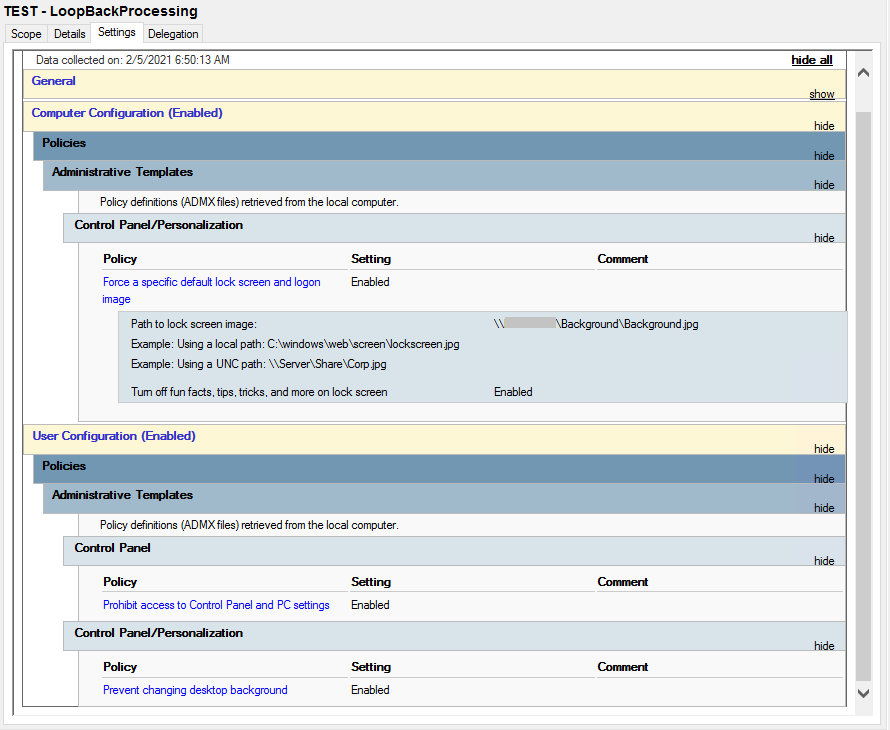

Loopback processing gpo full#
In this scenario, you have full control over the computers and users in this domain because you have been granted domain administrator rights. To describe the loopback feature, we’ll use an example. The Group Policy loopback feature gives the administrator the ability to apply Group Policy, based upon the computer that the user is logging onto. However, in some cases, users may need policy applied to them, based upon the location of the computer object, not the location of the user object. Group Policy is applied to the user or computer, based upon where the user or computer object is located in the Active Directory. Group Policy Loopback Support as described in MS whitepaper:
Loopback processing gpo windows#
Then Windows 2000 GPOs are applied, starting with Local GPO. Then Windows NT ntuser.pol is applied if the user is from a Windows NT 4.0 Domain that uses System Policy. Then Windows 2000 GPOs are applied, starting with Local GPO – This is the only one if the computer is in a Windows NT 4.0 Domain.ĭetailed User Configuration Application Order: Mandatory/Roaming Profile, if present, is applied first. GPOs assigned to user during logon (User sections of the policy)Local Machine Policy Site GPOs Domain GPOs OU GPOs ĭetailed Computer Configuration Application Order: Windows NT System Policies, if the computer is a member of a Windows NT 4.0 Domain that uses them, are applied first. In terms of order of operations, the GPOs would be applied in this order: LMP,S1,N,U,S2,D,T,B GPOs assigned to user during logon (User sections of the policy)Local Machine Policy Site GPOs Domain GPOs OU GPOs Local Machine Policy Site GPOs Domain GPOs OU GPOs GPOs assigned to local machine during boot (Computer sections of the policy) Which processing order to use is determined by the GPO which is applied to the computer. User GPO processing can be configured three different ways, as documented below. The User section of a GPO is applied at user login. The Computer section of a GPO is applied during boot. GPOs can contain both computer and user sets of policies. They are then applied to computers and users in those containers. GPOs are assigned to containers (sites, domains, or OUs). UW Chief Information Security Officer (CISO).Then select the appropriate option ( Replace or Merge). Using Group Policy Management Console, edit the GPO you desire, expand Computer Configuration\Policies\Administrative Templates\System\Group Policy,Īnd then double-click User Group Policy Loopback Processing Mode. When users log on to Terminal Servers, the policy folder redirection is not applied. You need to enable this policy setting using the Replace mode on GPO linked to OU, where the Terminal Server’s computer accounts are (without folder redirection enabled). Use this configuration if you have users in your domain whose folders are redirected through policy, but you don’t want that redirect to occur when users log on through Terminal Services. Why is this configuration important to me? Because the computer’s GPOs are processed after the user’s GPOs, they have precedence if any of the settings conflict. NOTE: In case of conflict, the users policies from OU-TSSERVERS have precedence. User Configuration -> The configuration created in GPO linked to OU-SUPPORT.User Configuration -> The configuration created in GPO linked to OU-TSSERVER.When you define the “ User Group Loopback processing Mode“, to “ Merge” on the GPO linked to the OU-TSSERVER. (This is the difference in Replace Mode.) When you define the “ User Group Loopback processing Mode“, to “ Replace” on the GPO linked to the OU-TSSERVER. When configuring the policy Loopback Processing Mode, you can choose two different options, Replace and Merge. Now we are finally going to learn about User Group Policy Loopback Processing Mode.




 0 kommentar(er)
0 kommentar(er)
